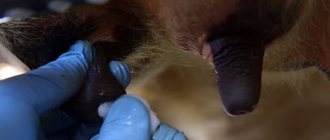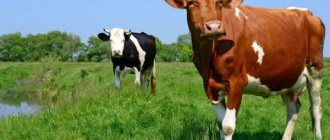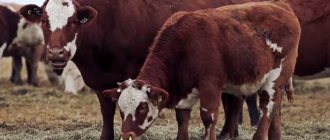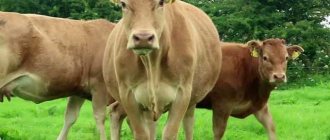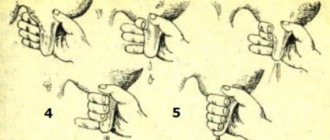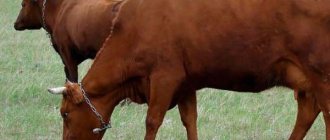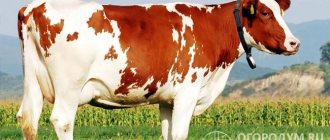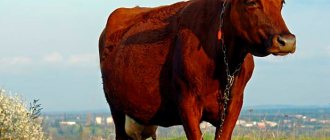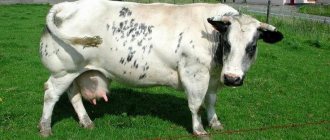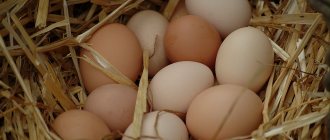Among the complications that occur in the first days after calving in cows, postpartum paresis is one of the most dangerous. The disease develops instantly and in an acute form, causing paralysis of the limbs, spasms of the larynx, disruption of the gastrointestinal tract and loss of consciousness. It is important to provide emergency medical care to the cow, otherwise serious complications and death are possible.
Treatment methods for paresis in cows
Veterinary specialists only recently learned how to treat this disease.
Schmidt's unique method is highly effective in the treatment of postpartum paresis, which consists of pumping air into the cow's mammary glands using an Evers device, or a pump from a regular bicycle through the mammary canals. In case of paresis, the cow's udder is pumped with air using the Evers device.
Using this method, treatment can be carried out both at home and on the farm. What is important is the high level of effectiveness of this treatment method.
After this, it is necessary to sterilize the cow’s teats and the hose from the Evers device, or from the pump, using medical alcohol. A cotton pad should be attached to the hose as a tip to prevent infection from entering the cavity of the mammary glands.
First, a catheter must be carefully inserted into the cow's milk canal (teat), through which air can slowly begin to be pumped into the cavity of the mammary glands. The process of pumping up the mammary glands should take place very slowly to create a more intense effect on the receptors. It is necessary to pump the cow's udder through each milk canal in several approaches, accompanying this process with a light massage of the udder.
When pumping up the mammary glands, it is very important to ensure that the skin on the surface of the udder is not stretched too tightly and is not overstrained. Otherwise, pumping the udder can lead to rupture of the alveoli and the formation of emphysema.
While inflating the udder, care should be taken not to stretch the skin too much.
With the correct procedure for pumping up the mammary glands, all existing folds on the nipples should straighten, and when you tap the udder with a finger, a sound should appear, like tapping an inflated cheek.
At the end of the procedure, you need to massage the nipples a little to activate the processes of muscle contractions. In the case when air immediately begins to escape from the nipples against the background of strong relaxation of the muscle fibers, it is recommended to rub the surface of the nipple with some kind of cloth, for example, a bandage or gauze. After this, apply a gauze bandage to the milk ducts and leave it for a couple of hours.
The cow's condition may improve within a few hours, but in most cases the healing process occurs at a slow pace. After the cow gets to her feet, she will have tremors for some time in the limb area.
If there is no improvement in the cow's condition 8 hours after treatment using the Schmidt method, the treatment must be repeated. For higher treatment effectiveness, it is recommended to wrap the cow’s body in cloth and rub the side surfaces. To free the intestines from stagnation of feces, it is necessary to carry out the procedure of infusion of a strong, warm enema.
When tympania develops against the background of postpartum paresis in a cow, it is necessary to puncture the rumen. To do this, 30-40 ml of a forty percent formaldehyde solution must be injected into the protruding scar on the side surface of the cow’s body.
Another method of treating cows with postpartum paresis is to infuse the mammary glands of the sick animal with fresh milk obtained from a healthy individual. This method is also highly effective; improvements occur within 60 minutes after the procedure.
Another way to treat paresis is to infuse the mammary glands with fresh milk from a healthy cow.
If the above-described treatment methods are ineffective, it is recommended to slaughter the cow.
Treatment
In addition to increasing pressure with the help of special drugs, treatment is accompanied by blowing air into the female’s udder.
This method was developed at the end of the nineteenth century and is characterized by the use of a special Everas apparatus or a conventional bicycle pump. The procedure begins with complete expression of milk from the ducts, as well as disinfection of instruments and teats of the cow.
Smooth air injection with careful straightening of folds is accompanied by massage movements. You should be careful that the udder does not inflate too much, otherwise these actions may lead to injury.
The end of air pumping of each nipple during postpartum paresis is bandaging. With proper assistance, improvements can occur within half an hour. The procedure must be repeated if paralysis persists for about 8 hours.
Symptoms and diagnosis
Most often, the first signs of illness in a cow appear a couple of days after calving. In rare cases, they occur during the maternity period or a couple of weeks or even months after calving has occurred. A cut is characterized by the following symptoms:
- stopping chewing gum;
- the cow often steps from foot to foot;
- muscle twitching develops. Also characteristic is a symptom such as trembling of the limbs;
- unsteady gait.
If the disease is not treated, then the cow falls and attempts to rise do not always end in success. In a milder form of the pathology, the cow has an S-shaped curved neck when lying down. In severe cases of the disease, the animal lies on its side, throwing its head back onto its chest and stretching its limbs. The pupils dilate and the cornea becomes cloudy. Usually the eyes are in a semi-closed state. The tongue falls out of the slightly open mouth, mucus drips from it.
Increased risk of comorbidities
During the calving period, a dairy cow must sharply rebuild its metabolism from the dry phase to the productive phase. The need for calcium increases greatly due to the fact that 1 kg of milk produced requires 2.3 g of this macronutrient, and in highly productive animals it can significantly exceed 150 g per day. In addition, calcium metabolism in the first days of lactation has not yet adjusted to the increased need, and to a greater extent in cows with high milk yields. Animals from the second day of lactation, and especially animals that have had milk fever in the past, have an increased risk of developing hypocalcemia.
Increased risk of disease due to hypocalcemia
- Mastitis: 8.1 times
- Ketosis/fatty liver: 8.9 times
- Abomasum displacement: 3.4 times
- Metritis / placenta retention: 3.2 times
- Complications of childbirth: 6.5 times
Calcium is one of the most important minerals and is stored primarily in the bones. In the metabolism of the dairy cow, calcium plays a central role and is crucial for the smooth functioning of muscle activity, a well-functioning immune system and the activation of various enzymes and the endogenous hormonal system. This also explains why milk fever favors such a wide range of comorbidities. Parturition paresis has been shown to significantly increase the risk of major dairy cow diseases such as mastitis, ketosis, fatty liver, abomasum displacement, uterine inflammation and complications during birth.
When calcium is administered orally in the form of boluses, due to the waxy coating and slow breakdown in the rumen, there are no problems with the poor taste of acidic salts. Calcium in bolus form avoids incomplete intake of calcium compounds, for example due to spitting out liquid forms, and provides effective prevention of hypocalcemia.
Possible problems
A cow, like any animal, is susceptible to diseases, so if it begins to behave unnaturally, it is worth taking a closer look at its state of health. After the first calving, there may be bleeding, which is stopped with oxytocin.
Due to bearing calves, the cow often develops postpartum paresis. This disease is characterized by a lack of calcium in the body. But paresis usually has symptoms that affect the animal’s body as a whole:
- The cow doesn't eat anything;
- The cow's temperature drops;
- Distribution is impossible because the milk disappears;
- The cow fell on her feet, everything is leading to paralysis of her limbs.
In this case, you cannot hesitate and wait for the animal to recover. Paresis is treated by a veterinarian, since it will be difficult to raise the animal to its feet, and sometimes the disease is fatal. The cut is eliminated by administering caffeine and Calfocet, as well as other medications.
To prevent the development of paresis, you need to pay attention to feeding; a balanced diet will also prevent vitamin deficiency
Deposit
Sometimes it is difficult for a calving cow to get up; she may simply lie down for a long time. This indicates postpartum retention. What to do in this case? Here you will also need the help of a doctor. It is difficult to say how long the treatment of the disease can take. If the veterinarian begins treatment immediately, then you can get rid of the signs within a week. In case of severe illness, the doctor raises the animal longer, about 2 weeks. If this is delayed, no one will answer how many days the treatment will last, because complications lead to the fact that cows get sick longer and cannot quickly return to normal.
On the first day, when the animal is weakened, there is a chance of contracting mastitis. The cause may be mechanical damage to the milking or the ingress of bacteria. Signs of mastitis appear when one lobe of the udder has a lump, something hard and uneven in the udder. When faced with bad signs after calving, do a small test. During the colostrum period, it is necessary to place the colostrum in a test tube for one hour; if it stratifies, this indicates a disease. Caring for a calf after birth should exclude drinking milk from a cow, since the animal can be infected, which will cause its death. We feed the calves milk from another cow or give them special substitutes that are rich in vitamins and microelements. Feeding lasts for a period that depends on whether the mother's milk has become normal.
Fertilization
Having calved, after some time the animal is again ready to carry out fertilization. As soon as the female cow comes into heat, if there are no health problems, she is ready for insemination.
Hunting occurs when the owner sees a swollen rear end and a discharge appears from the vagina. The time when a new heat begins depends on the calving time. Cows walk once a year. Usually cows come into heat 45 days after giving birth. Of course, this is an approximate period, but if the animal is taking too long, you need to contact a veterinarian. Sometimes in such cases the opportunity to give birth will completely disappear.
The hunt is characterized by the fact that the animals eat poorly and begin to walk around the barn, worried. The cow yells and changes in character.
Main diseases of calves
Names for bulls and heifers in home and breeding
The problem of papillomas in a cow
Risk group and reasons
This pathological condition has not been fully studied today, so experts find it difficult to name the exact causes of paresis. However, based on numerous observations and studies, the following possible causes and predisposing factors have been established:
- the presence in the diet of a large amount of protein feed (concentrates, cereals and legumes);
- large mass of the animal;
- high milk yield;
- calcium deficiency in the body;
- dysfunction of the parathyroid gland;
- excessive exhaustion of the nervous system and stress;
- The age of the animal is in the range of 5–8 lactations.
Based on the foregoing, it is possible to understand which animals are at risk for the development of postpartum paresis. First of all, these are highly productive cows (Jersey, black and white breeds), which, when producing large amounts of milk, lose a significant part of calcium from the body.
Symptoms and signs of paresis
Maternity paresis in a cow develops rapidly, so at the first signs you need to consult a doctor. In the first 12 hours after calving, about 80% of animals are susceptible to complications; in the first 3 days, about 30%. That is, in the first hours after birth, signs of paresis may appear in most cases, and over time, the incidence of the disease decreases. But this does not mean that signs of the disease cannot appear after 2-3 weeks, so carefully monitor the cattle so as not to miss the onset of labor paresis in the cow.
Immediately after calving, the animal's blood pressure should drop and recover within 10-12 hours. If this does not happen, then this should be the first signal about the risk of developing the disease.
- Appetite suddenly disappears. The cow stops chewing the cud.
- The cow's colostrum (milk) disappears.
- Active trembling of the limbs begins, muscle weakness appears. The animal stands unsteadily on its feet, and then lies down, laying its head on its chest. Attempts to stand up are not successful, and the neck bends in an S-shape.
- Body temperature drops to 36-35 degrees. First the limbs get cold, and then the whole body.
- The sensitivity of the cow's skin sharply decreases. When tingled with a sharp object along the spine, the animal does not react.
- The pupils dilate, the cornea becomes cloudy, the eyes are half-closed.
- Breathing becomes wheezing and harsh.
- The animal stops peristalsis. There is no urination or defecation.
- In severe cases, the tongue falls out. Excessive salivation may be present.
Paresis in a cow is a rapid disease, so the first thing to do is to inform the veterinarian about the suspicion of the disease so that he can act immediately. Quick and competent manipulations by a specialist will reduce the risk of death of the animal to 5%.
Treatment of paresis in cows involves influencing the baroceptors of the udder, or rather, blowing air into it. To do this, the animal is placed in a dorsal-lateral position and, using sterile catheters, air is forced into all openings of the udder.
The severe condition of postpartum paresis in cows is relieved by intravenous administration of a solution of calcium chloride and glucose to restore the lack of trace elements and sugars in the body, as well as caffeine to raise blood pressure. If the doctor provided proper assistance in a timely manner, then within 12-15 hours the animal will be able to get back on its feet, and after 2-3 days it will recover.
You can help the cow with a warm rubdown or a hot enema. It is also recommended to inject formalin into the scar to consolidate the result and reduce the risk of complications in the form of tissue inflammation.
The treatment procedure using the Schmidt method (injecting air into the udder) requires skill, experience and equipment. It is difficult to perform the operation on your own without preparation. But folk remedies, or rather, alternative techniques, will help with paresis in a calving cow. Such methods include the introduction of fresh milk from a healthy cow into the udder of an animal.
When carrying out the procedure using sterile instruments, up to 2 liters of milk from a healthy cow are injected into each lobe of the udder, but the effect can only be expected if you notice signs of the disease in the early stages. The treatment is easier and faster; in 30-40 minutes the cow will be on its feet.
Causes
The main cause of the disease is not clear, but its occurrence is associated with a cold in the animal during pregnancy and during childbirth. The accelerated functioning of the pancreas also affects. As a result, excess insulin is produced, and the first symptoms of paresis begin to appear.
Other reasons:
- large milk yields;
- overweight;
- keeping the animal in a stall for a long time in winter;
- feeding with concentrated food;
- metabolic problems.
What to do to treat postpartum paresis in cows
Paresis occurs within 24 hours, sometimes 2-3 days after the birth of the calf.
Paresis occurs within 24 hours, sometimes 2-3 days after the birth of the calf; less commonly, the condition is observed weeks or months after calving.
Signs of the disease progress rapidly:
- The first thing that disappears is the chewing gum. The animal is excited, marks time, muscles tremble, and staggers when trying to walk.
- After some time, coordination of movements is lost, the cow falls, gets up, and falls again.
- With a mild course of the pathology, the body temperature decreases slightly, the neck is curved, but the head remains suspended. The animal refuses to eat and drink.
- A severe type of disease is characterized by a lack of movement: the cow lies with her limbs tucked in and her head turned to the side. If you pull the horns, the head can be raised straight, but it returns to its original position.
- The pupils dilate, the cornea becomes cloudy, the eyelids are half-closed, and lacrimation is observed.
- The mouth is slightly open, due to paralysis of the pharynx, saliva accumulates in it, the tongue hangs to one side.
- The female breathes heavily, making wheezing sounds.
- The veins on the udder are swollen, milk is separated sparingly or absent.
- There is a decrease in temperature indicators to 35-36 °C.
- Does not respond to tingling with a needle.
Be sure to read:
Sores on the udder of a cow: how to treat pustules and other diseases
Atony is almost always observed - a disorder or absence of motility of the proventriculus; sometimes an accumulation of air is detected in the rumen due to a violation of the passage of gases (tympany). Intestinal peristalsis stops, there is no excretion of feces and urine.
The severe course and rapid progression of the disease make treatment difficult, so do not delay calling the veterinarian.
An effective means of treating paresis is considered to be the use of the Schmidt technique, when air is pumped into the udder of a sick animal using the Evers apparatus.
Be sure to read:
Ketosis in cows: causes of development, symptoms and treatment methods
How the procedure is carried out:
- To perform the manipulations, the cow is laid on its side, and excess milk is milked.
- The nipples are treated with alcohol, the concentration of the composition is not higher than 70%.
- Having sterilized the catheter, it is inserted into the nipple canals and air is gradually pumped into the apparatus.
- If the sphincter is weak and there is loss of air, the nipples are tightened with a flat piece of fabric and left for 2 hours.
- The dosage is determined by skin tension, straightening of folds, and the tympanic sound that occurs when snapping your fingers.
| A drug | Percentage of solution | Dosage (ml) | Method of administration |
| Calcium chloride | 10% | 200-400 | into a vein |
| Glucose | 40% | 200-250 | into a vein |
| Caffeine sodium benzoate | 20% | 15-20 | Into the muscle |
| Magnesium sulfate | 25% | 40 | Into the muscle |
| Ergocalciferol (vitamin D) | 2500 000 units | Into the muscle |
In uncomplicated cases, Cordiamin is sometimes used into a vein and subcutaneous injections of oxytocin, the dose depends on the weight of the cow.
Usually, after all the manipulations, the cow’s condition improves, her temperature increases, she can get up and eat. When measures are unsuccessful, the animal is slaughtered.
In an immobilized cow, it is necessary to remove urine using massage or a catheter, and remove feces. When scar tissue is swollen, gases are removed by puncture with a trocar, then a solution of ichthyol or formalin is introduced into the cavity to prevent inflammation.
Folk remedies
Paresis poses a threat to the life of the cow, so folk recipes should not be used to eliminate the symptoms of the condition.
An alternative to the hardware method of air supply can be the introduction of fresh milk or milk from another cow heated to 48 °C (200-600 ml) into the udder; the volume depends on the size of the organ. A syringe and tube are used to smoothly inject the liquid.
To prevent the development of postpartum paresis, it is necessary to take preventive measures:
- During the start-up period, pregnant cows should not be overfed, concentrates should not be given in large volumes, the norm for pregnant animals is 1.5-2 kg.
- It is necessary to create a varied diet, taking into account the amount of vitamins and minerals, especially phosphorus, calcium and magnesium. Not all owners of private farms can balance nutrition, so it is recommended to use industrial premixes for cattle.
- If pregnancy occurs during the stall period, the cow must be given daily walks lasting at least 2 hours.
- 7-14 days before birth, concentrates and chopped vegetables are removed from the diet.
- 5 days before calving, it is allowed to feed up to 0.5 kg of sugar per day.
- A week in advance, an intramuscular injection of vitamin D2 is given at a dosage of 10 million units.
Be sure to read:
The first signs of leukemia in cows: how dangerous the disease is for humans, symptoms
Preventive actions
To avoid the occurrence of postpartum paresis in cows, the following preventive measures are recommended:
- Do not overfeed animals during confinement and during periods of declining lactation.
- Make sure that the cows' diet is varied and does not contain only concentrated feed.
- Follow the immunization schedule for pregnant cows.
- Within 5-8 days before calving, administer vitamin D2 intramuscularly to the cow at a dosage of 10 million units.
- Add premixes to your animal's food.
- After the calf is born, feed the cow with a special veterinary energy drink.
- A pregnant cow should stop feeding succulent feeds and concentrates for 2 weeks before calving. Cancellation of the diet is carried out only 10 days after the birth of the baby.
- 7 days before the onset of labor, start adding 300 grams of sugar or molasses to the animal’s food every day.
- Make sure you exercise regularly.
Postpartum paresis in cattle can be prevented by providing proper care and nutrition during housing. The main requirement is that the cows do not stagnate in the barn and are walked every day. In addition, timely immunization of pregnant cows and replenishment of missing vitamins and beneficial microelements is necessary.
After giving birth, you need to introduce restrictions on concentrates, using a variety of feeds instead. In this case, the farmer will be able to avoid such difficulties with animals.
Symptoms and signs
It happens that paresis occurs 4 or 5 hours before calving. You need to call a veterinarian immediately. 80 percent of cows begin to suffer within a 12 hour period after giving birth. Approximately 30 percent of cows may become ill within 3 days of giving birth. Until 21 or 25 days, frequent careful examination of the animal is advisable, even if everything is fine with it, since there is a possibility of the disease manifesting itself even at a later date.
The typical form of the disease manifests itself clearly. Atypical is characterized by paralysis.
Normally, the blood pressure of a large-horned individual that has given birth drops, which is restored after 10 or 12 hours. If after the required period of time the pressure has not returned to normal, you should be concerned. The animal is lethargic and its depressed state is noticeable.
Oncoming paralysis can be determined by a number of signs, for example, the disappearance of colostrum. The cow does not chew the cud and refuses food. The animal's muscles become weak and its limbs tremble. The cow cannot stand on its feet for long, so it lies down, it is comfortable in a position with its head on its chest, legs under itself. If the animal gets up, it falls again.
The neck will be curved. If you suspect an illness, your body temperature should be measured. If there is a disease, it drops to 36 or 35 degrees. If you touch the limbs, they will be cold, the decrease in temperature around the horns and ears is especially noticeable, after which the whole body begins to get cold.
The animal's skin becomes less sensitive. If you prick the skin of a cow near the vertebral area with a sharp object, it will not react.
Also noticeable is the dilation of the pupils and clouding of the cornea of the large-horned individual. She can barely open her eyes, she has to keep them half closed. The sick cow's eyes do not react to lighting.
The animal's wheezing, harsh breathing is observed. Peristalsis is not observed in him, as is urination and defecation. But sometimes there is vomiting and diarrhea. In severe cases of the disease, tongue prolapse may occur. The process of salivation will, on the contrary, be increased.
If the disease occurs before birth, the animal will not be able to calve, and the entire process is sharply suppressed. There is a drop in temperature. The atypical form is most often observed several days or hours before the cow is due to calve.
If the animal is affected by postpartum nervous disease, this can lead to further complications: postpartum or prenatal retention, delayed release of the placenta, mastitis, as well as inversion or prolapse of the uterus. It is better for a veterinarian to be present during the birth of a cow.
How to treat paresis in a cow after calving
Treatment for incomplete paralysis (paresis) should begin in an animal immediately, because its success will depend on this. It is noteworthy that previously there were practically no effective ways to cure females paralyzed after childbirth, but today several methods have been invented to help put cows on their feet. Next, we will consider the Schmidt method and the use of injection drugs. Giving a sick animal anything orally is strictly prohibited, since the swallowing process is impaired at this time and the animal may choke.
Schmidt method
This method was proposed back in 1898, and since then, postpartum paralysis of cows has ceased to be the main fear of livestock farmers. Despite its simplicity, the method gives amazing results. It involves pumping air into the udder lobes. The essence of the method is that the incoming air begins to irritate the interoreceptors and baroreceptors that sense blood pressure.
At the same time, blood pressure stabilizes, the ratio of inhibitory and irritable processes in the central nervous system is adjusted, metabolic processes are normalized, the biochemical composition of the blood changes (the level of glucose, calcium and phosphorus increases, and the amount of acetone and lactic acid decreases). To implement the method, a simple Evers apparatus is used, consisting of a milk catheter, a rubber bulb, and a connecting rubber tube.
Evers device Technique:
The animal must be laid on its side. If the udder is full, the milk must be milked. If the udder is slightly full, this is not necessary.
Wash all nipples clean and treat with antiseptic or alcohol, paying special attention to the tips. The catheter also needs to be sterilized and lubricated with Vaseline. Carefully insert the catheter into the first udder lobe (the one on which the animal lies) and slowly (!) begin to pump in air
You can understand that there is enough air by the special sound that is produced when you click your finger on the udder - the sound is the same as when you click your finger on an inflated cheek. After pumping air into all the lobes, you need to re-inflate those of them that were processed first. To prevent air from escaping from the udder, you need to squeeze the nipple a little and carefully bandage it with gauze or wide tape for 30–40 minutes. Thread cannot be used. The animal must be forced to lie on its stomach and bend its hind legs to create even more pressure in the udder. The sacrum and lumbar area, as well as the chest, should be rubbed with active but gentle massage movements. The animal can be warmed in this way: cover with a thick blanket, warm up the iron well and iron the lumbar area. Then the cow should be wrapped. Under no circumstances should drafts be allowed in a room with a sick animal.
Important! Air must be introduced into the nipples very slowly so as not to rupture the alveoli or damage the parenchyma, otherwise there will be a decrease in productivity. It is also necessary to correctly determine the amount of air, because if the injection is insufficient, the therapeutic effect will not occur.
Intravenous injection
Intravenous injections can be used alone if the above method is not available, or combined for greater effectiveness. For paresis, the animal should be given caffeine, calcium and magnesium supplements, glucose, and vitamin D.
The cow has calved - find out what to do next.
It is necessary to inject calcium chloride with glucose in the following dosage per cow: 30 ml of calcium, 75 ml of glucose and 300 ml of distillate. You can also use calcium gluconate 20% in a dosage of 5 ml per 10 kg of animal weight or hormonal drugs, for example ACTH or Cortisone, according to the instructions. A 5% glucose solution can be administered intravenously in an amount of 2000 ml per individual.
Other actions after air injection and injection:
- 1–2 hours after the cow begins to rise to her feet, you need to milk some of the milk. After another 3-4 hours, milk the rest.
- Not earlier than after 12 hours, you need to give 1 liter of heated water to drink. After an hour, give another 3 liters, gradually increasing the volume.
- After passing stool, you can do an enema.
The advantage of this method is that it never leads to rupture of the alveoli and does not further reduce the milk production of the female. Improvement should occur within 1–1.5 hours; if there are no changes, it is necessary to repeat the procedure with the same udder lobe.
Did you know? To obtain 1 kg of butter, it is necessary to process 20 times more milk.
Feeding
A large amount of protein concentrates often leads to rapid weight gain in cattle, metabolic and gastric disorders, which can cause postpartum paresis.
A properly formulated diet, aimed at using a variety of foods, including coarse grass, contributes to the normal functioning of body systems. A balanced diet for livestock leads to a stable supply of all vitamins and microelements, especially during the pregnancy period.
Main symptoms
Basically, paresis develops soon after calving - after 4-5 hours, very rarely occurs during childbirth. Paresis can occur in a heifer every year with each birth, even if they are relatively quick and easy. A paralytic condition develops in the body when levels of magnesium and phosphorus increase along with a decrease in the amount of calcium (hypocalcemia).
Find out why the cow does not get back on her feet after calving.
Although we said that paresis occurs a few hours after calving, in fact this pathological process, or rather its first phases, develops during childbirth:
Phase I
A very short stage (birth), which usually goes unnoticed, since all attention is directed to the adoption of the calf. During the first phase, it can be noted that the cow is weakened, has increased pain sensitivity and excitability, moves slowly with her hind limbs stretching along the ground
Phase II. Continues for 1–12 hours after the calf is born. This phase is characterized by the following symptoms: the animal is weakened, the temperature may be within normal limits or reduced to +37.5 ° C, the peristalsis of the forestomach is disrupted, a slight lack of coordination is observed, the animal does not eat, urination and defecation are either absent or frequent, but in small portions.
Phase III. At this stage, all the classic manifestations of postpartum paresis begin: severe weakness, the animal constantly lies down, the neck takes an S-shape, the temperature can drop to +35 ° C, the limbs become cold, pain sensitivity is reduced or absent, constipation, bladder overflow and inability empty, tempania may begin (the rumen becomes full of gases). The animal's breathing becomes heavy, accompanied by wheezing. With paresis, milk is either not released at all, or its amount is insignificant, and the veins in the udder swell. The animal's unconscious state progresses, soon leading to coma.
Important! Without treatment, the animal can die within a few hours!
Body position of a cow during paresis Paresis can occur in several forms:
- typical: the animal responds well to therapy, the symptoms subside, the cow gradually gets back on her feet;
- atypical: treatment does not give positive dynamics, despite the fact that the body is in physiological norm, the animal is not able to rise to its feet, attempts may cause dislocations, ruptures of muscles and tendons, but prolonged lying is no less dangerous - bedsores develop;
- subclinical - the female has decreased appetite and muscle tone of the proventriculus and smooth muscles, which causes retained placenta and edema.
Factors in the development of pathology
The disease is accompanied by a coma-like state. The cow stops responding to external stimuli. Excitation and inhibition in the central nervous system play practical significance in the development of pathology. As a rule, paresis is preceded by a state of general activity of the body, which is then replaced by a sharp decrease in general tone, muscle weakness, loss of appetite and other symptoms.
In this connection, postpartum paresis is considered to be a violation of neurohumoral processes in the nervous system. The rapid change of phases of excitation and inhibition and the general clinical picture correspond to this concept.
Factors causing the development of the disease:
- Imbalance of nutrients in the diet. Especially calcium and phosphorus, as well as a lack of vitamin D.
- Protein overfeeding.
- Disturbance of calcium-magnesium metabolism.
- Failure in the endocrine system.
This is interesting
It is worth noting that the exact cause of the development of the disease has not been established. Experimental methods have not been able to prove that the listed factors actually cause postpartum paresis. In the body of sick animals, there is a significant drop in the level of sugar and calcium in the blood. This is due to disruption of the endocrine glands.
